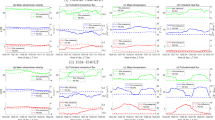Abstract
A method is presented for selecting the optimal flight patterns for airbornemeteorological measurements in various flow situations. The method is basedon systematic utilisation of mesoscale model fields. Flow overan Arctic sea-ice boundary zone is modelled, and it is assumed that the mesoscale model fields represent the true state of the atmosphere, and that each possible flight pattern yields a different sample of the true fields. A plan for the basic structure of the flight pattern is assumed, and then the unexplained variance, i.e., the difference between the true variance and the sample variance, of a quantity of interest is calculated for a variety of possible flight patterns. Different target quantities are considered, such as wind speed, air temperature, and the turbulent fluxesof momentum and sensible heat. The optimal flight pattern is defined byminimisation of the unexplained variance, and often depends on the quantitywe are interested in. For sawtooth patterns, the optimal flight pattern was sensitive to the maximum ascent angle of the aircraft. In flight patterns designed for turbulence measurements, the optimal pattern was different for the unexplained variance of the turbulent fluxes and for the unexplained total heat content of the convective layer.
Similar content being viewed by others
References
Alestalo, M. and Savijärvi, H.: 1985, ‘Mesoscale Circulations in a Hydrostatic Model: Coastal Convergence and Orographic Lifting’, Tellus 37A, 156–162.
Andreas, E. L.: 1987, ‘A Theory for the Scalar Roughness and the Scalar Transfer Coefficients over Snow and Sea Ice’, Boundary-Layer Meteorol. 38, 159–184.
Bange, J. and Roth, R.: 1999, ‘Helicopter-Borne Flux Measurements in the Nocturnal Boundary Layer over Land —A Case Study’, Boundary-Layer Meteorol. 92, 295–325.
Brümmer, B.: 1997, ‘Boundary Layer Mass, Water, and Heat Budgets in Wintertime Cold-Air Outbreaks from the Arctic Sea Ice’, Mon. Wea. Rev. 125, 1824–1837.
Brümmer, B. and Müller, G.: 1999, ‘Boundary Layer Measurements with Research Aircraft Falcon’, in J. Launiainen (ed.), BALTEX-BASIS Data Report 1998, Int. BALTEX Secretariat Publ. No. 14, Geesthacht, Germany, 94 pp.
Brümmer, B., Busack, B., and Hoeber, H.: 1994, ‘Boundary-Layer Observations over Water and Arctic Sea-Ice during On-Ice Air Flow’, Boundary-Layer Meteorol. 68, 75–108.
Grunwald, J., Kalthoff, N., Fiedler, F., and Corsmeier, U.: 1998, ‘Application of Different Flight Strategies to Determine Areally Averaged Turbulent fluxes’, Contr. Atmos. Phys. 71, 283–302.
Hartmann, J.: 1990, Airborne Turbulence Measurements in the Maritime Convective Boundary Layer, Ph.D. Thesis, Flinders University of South Australia, 163 pp.
Hartmann, J., Kottmeier, C., and Wamser, C.: 1992, ‘Radiation and Eddy Flux Experiment 1991 (REFLEX I)’, Rep. Polar Res. 105, Alfred-Wegener-Institute for Polar and Marine Res., Bremerhaven, Germany, 72 pp.
Hartmann, J., Bochert, A., Freese, D., Kottmeier, C., Nagel, D., and Reuter, A.: 1997, ‘Radiation and Eddy Flux Experiment 1995 (REFLEX III)’, Rep. Polar Res. 218, Alfred-Wegener-Institute for Polar and Marine Res., Bremerhaven, Germany, 74 pp.
Hartmann, J., Albers, F., Argentini, S., Bochert, A., Bonafe, U., Cohrs, W., Conidi, A., Freese, D., Georgiadis, T., Ippoliti, A., Kaleschke, L., Lüpkes, C., Maixner, U., Mastrantonio, G., Ravegnani, F., Reuter, A., Trivellone, G., and Viola, A.: 1999, ‘Arctic Radiation and Turbulence Interaction Study (ARTIST)’, Rep. Polar Res. 305, Alfred-Wegener-Institute for Polar and Marine Res., Bremerhaven, Germany, 81 pp.
Heinemann, G.: 1999, ‘The KABEG'97 Field Experiment: An Aircraft-Based Study of Katabatic Wind Dynamics over the Greenland Ice Sheet’, Boundary-Layer Meteorol. 93, 75–116.
Högström, U.: 1988, ‘Non-Dimensional Wind and Temperature Profiles in the Atmospheric Surface Layer: A Re-Evaluation’, Boundary-Layer Meteorol. 42, 55–78.
Holtslag, A. A. M. and de Bruin, H. A. R.: 1988, ‘Applied Modeling of the Nighttime Surface Energy Balance over Land’, J. Appl. Meteorol. 37, 689–704.
Kottmeier, C., Hartmann, J., Wamser, C., Bochert, A., Lüpkes, C., Freese, D., and Cohrs, W.: 1994, ‘Radiation and Eddy Flux Experiment 1993 (REFLEX II)’, Rep. Polar Res. 133, Alfred-Wegener-Institut fur Polar and Marine Res., Bremerhaven, Germany, 62 pp.
Launiainen, J.: 1983, ‘Parameterization of the Water Vapour Flux over a Water Surface by the Bulk Aerodynamic Method’, Ann. Geophys. 1, 481–492.
Lüpkes, C. and Schlünzen, K. H.: 1996, ‘Modelling the Arctic Convective Boundary-Layer with Different Turbulence Parameterizations’, Boundary-Layer Meteorol. 79, 107–130.
Mahrt, L.: 1998, ‘Flux Sampling Errors for Aircraft and Towers’, J. Atmos. Oceanic Tech. 15, 416–429.
Mai, S., Wamser, C., and Kottmeier, C.: 1996, ‘Geometric and Aerodynamic Roughness of Sea Ice’, Boundary-Layer Meteorol. 77, 233–248.
Makshtas, A. P.: 1991, The Heat Budget of Arctic Ice in the Winter, Int. Glaciol. Soc., Cambridge, U.K., 77 pp.
Mann, J. and Lenschow, D. H.: 1994, ‘Errors in Airborne Flux Measurements’, J. Geophys. Res. 99, 14,519–14,526.
Roth, R., Hofmann, M., and Wode, C.: 1999, ‘Geostrophic Wind, Gradient Wind, Thermal Wind and the Vertical Wind Profile —A Sample Analysis within a Planetary Boundary Layer over Arctic Sea-Ice’, Boundary-Layer Meteorol. 92, 327–339.
Santoso, E. and Stull, R.: 1999, ‘Use of Synthetic Data to Test Flight Patterns for a Boundary Layer Field Experiment’, J. Atmos. Oceanic Tech. 16, 1157–1171.
Savijärvi, H.: 1991, ‘The United States Great Plains Diurnal ABL Variation and the Nocturnal Low-Level Jet’, Mon. Wea. Rev. 119, 833–840.
Smith, S. D.: 1988, ‘Coefficients for Sea Surface Wind Stress, Heat Flux, and Wind Profiles as a Function of Wind Speed and Temperature’, J. Geophys. Res. 93, 15,467–15,472.
Tjernström, M., and Samuelsson, P.: 1995, ‘The Effect of Inertial Navigation System Time Response on Airborne Turbulence Measurements’, J. Atmos. Oceanic Tech. 12, 1196–1213.
Vickers, D. and Mahrt, L.: 1997, ‘Quality Control and Flux Sampling Problems for Tower and Aircraft Data’, J. Atmos. Oceanic Tech. 14, 512–526.
Vihma, T.: 1995, ‘Subgrid Parameterization of Surface Heat and Momentum Fluxes over Polar Oceans’, J. Geophys. Res. 100, 22,625–22,646.
Author information
Authors and Affiliations
Rights and permissions
About this article
Cite this article
Vihma, T., Kottmeier, C. A Modelling Approach For Optimizing Flight Patterns In Airborne Meteorological Measurements. Boundary-Layer Meteorology 95, 211–230 (2000). https://doi.org/10.1023/A:1002634613282
Issue Date:
DOI: https://doi.org/10.1023/A:1002634613282




